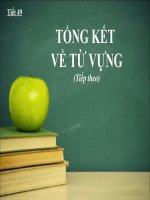THE USE OF RUBRICS TO SELFREGULATE STUDENTS’ WRITING PROCESS PERCEPTIONS AND PRACTICE = sử DỤNG BẢNG TIÊU CHÍ CHẤM TRONG VIỆC tự điều CHỈNH QUÁ TRÌNH VIẾT của SINH VIÊN NHẬN THỨC và THỰC HÀNH
Bạn đang xem bản rút gọn của tài liệu. Xem và tải ngay bản đầy đủ của tài liệu tại đây (1.2 MB, 95 trang )
VIETNAM NATIONAL UNIVERSITY, HANOI
UNIVERSITY OF LANGUAGES AND INTERNATIONAL STUDIES
FACULTY OF ENGLISH LANGUAGE TEACHER EDUCATION
GRADUATION PAPER
THE USE OF RUBRICS TO SELFREGULATE STUDENTS’ WRITING
PROCESS: PERCEPTIONS AND PRACTICE
Supervisor: Nguyen Thi Thu Hang, Ph.D
Student: Do Hai Yen
Course: QH2017.E3
HÀ NỘI – NĂM 2021
ĐẠI HỌC QUỐC GIA HÀ NỘI
TRƯỜNG ĐẠI HỌC NGOẠI NGỮ
KHOA SƯ PHẠM TIẾNG ANH
KHÓA LUẬN TỐT NGHIỆP
SỬ DỤNG BẢNG TIÊU CHÍ CHẤM TRONG
VIỆC TỰ ĐIỀU CHỈNH Q TRÌNH VIẾT
CỦA SINH VIÊN: NHẬN THỨC VÀ
THỰC HÀNH
Giáo viên hướng dẫn: TS. Nguyễn Thị Thu Hằng
Sinh viên: Đỗ Hải Yến
Khóa: QH2017.E3
HÀ NỘI – NĂM 2021
ACCEPTANCE PAGE
I hereby state that I, Do Hai Yen, QH2017.E3, being a candidate for the degree of
Bachelor of Arts accept the requirements of the College relating to the retention and use
of Bachelor’s Graduation Paper deposited in the library.
In terms of these conditions, I agree that the origin of my paper deposited in the library
should be accessible for the purposes of study and research, in accordance with the
normal conditions established by the librarian for the care, loan or reproduction of the
paper.
May 4th, 2021
i
ACKNOWLEDGEMENT
This graduation paper would not have been possible without the guidance and the help
of several individuals who in one way or another extended their valuable assistance in
the preparation and completion of this study.
First and foremost, I would like to express my deepest gratitude to my supervisor - Dr.
Nguyen Thi Thu Hang - for her constant support and encouragement. It was her
expertise and research experience that guided me from the initial to the end of this
graduation paper.
Also, I am immensely indebted to 368 first-year Fast track students and three lecturers
of the 2B Writing Division. Their participation and cooperation throughout the data
collection process has been the deciding factor to the completion of this study.
It is also a pleasure to thank Ms. Le Thuy Duong - my academic consultant - for showing
kind concern and consideration to me, as well as providing me with critical comments
and suggestions for the improvement of my research paper.
In addition, I owe my beloved family a big thanks for their unconditional love, patience
and care when I hurdled all the obstacles in the completion of this thesis. I sincerely
thank my grandparents for cooking me tasty and nutritious lunch every day, thank my
parents for having confidence in me, and thank my little sister for shouldering the burden
of housework. Words cannot express how grateful I am to all of them and for their
sacrifices that were made on my behalf.
Last but not least, my gratitude is extended to my close friends - Nguyen Thanh Mai,
Nguyen Viet Hoang - for standing by me and being sleepless together when I am down
and stressed. Thank my soulmate - Cao Thi Sao Mai and my deskmates - Pham Khanh
Duyen and Duong Kim Dung for having supported me mentally, physically and
academically.
ii
ABSTRACT
Rubrics are increasingly acknowledged for their potential in facilitating and promoting
students’ learning autonomy. Research on the instructional benefits of rubrics,
nonetheless, centers primarily on content subjects rather than foreign language contexts
such as EFL writing classes. This paper investigated the relationship between students’
use of rubrics and their writing self-regulation, as perceived by both the students and
their instructors. Data were collected through questionnaires and follow-up interviews
with 368 first-year English-majored students and three university lecturers respectively.
The findings indicate that in general the rubric was considered useful for fostering the
writers’ self-regulation by directing them through the stages of goal-setting, planning,
revising and editing. Nevertheless, most students favored the use of rubric in setting
goals, planning and revising their work rather than in editing, demonstrated by the
frequency and rated effectiveness of rubric use in each stage. The use of rubric was also
associated with other benefits such as clarifying teachers’ expectations or indicating
writers’ strengths and weaknesses, though there still existed obstacles mainly related to
the language used in rubrics and the kind of support provided to students. It is possible
that those shortcomings will be remedied by the changes in teachers’ instructions and
the creation of more generic versions of the rubric - checklists.
iii
TABLE OF CONTENTS
ACCEPTANCE PAGE
i
ACKNOWLEDGEMENT
ii
ABSTRACT
iii
TABLE OF CONTENTS
iv
ABBREVIATIONS
v
LIST OF TABLES AND FIGURES
vi
CHAPTER 1: INTRODUCTION
1.1. Statement of the problem
1
1.2. Research aims and Research questions
3
1.3. Significance of the study
4
1.4. Scope of the study
4
1.5. Organization
5
CHAPTER 2: LITERATURE REVIEW
2.1. Rubric
6
2.1.1. Definition of rubric
6
2.1.2. Rubrics for writing
7
2.1.3. Types of writing rubrics
8
2.1.3.1. Holistic and Analytic rubrics
8
2.1.3.2. General and Task-specific
8
iv
2.1.4. Roles of rubrics
10
2.1.5. Effects of instructional rubrics on students’ writing
10
2.2. Self-regulation
12
2.2.1. Definition of self-regulation
12
2.2.2. Self-regulation in writing
14
2.2.3. Effects of self-regulation on writing
14
2.2.4. Effects of rubrics on writing self-regulation
15
2.3. Related studies
17
CHAPTER 3: METHODOLOGY
3.1. Research design
20
3.2. Sampling and participants
20
3.3. Instruments
21
3.3.1. Questionnaire
21
3.3.2. Interview
22
3.4. Data collection procedure
23
3.4.1. Piloting
23
3.4.2. Administration of questionnaire
24
3.4.3. Administration of interviews
24
3.4.3.1. Interviews with students
3.4.3.2. Interviews with lecturers
v
3.5. Data analysis
25
CHAPTER 4: FINDING AND DISCUSSION
4.1. Research question 1: The way the rubric in the Course Guide is used by
26
students at different stages of the writing process
4.2. Research question 2: Student’s perception of the effectiveness of rubric
34
use for writing self-regulation
4.3. Research question 3: Students’ perceptions of the benefits and obstacles
38
of using rubrics to self-regulate their writing process
4.4. Research question 4: Students’ suggestions to improve the effectiveness
44
of rubric use in writing self-regulation
CHAPTER 5: CONCLUSION
5.1. Major findings of the study
48
5.2. Pedagogical implications
49
5.3. Limitations
50
5.4. Suggestions for further studies
51
REFERENCES
52
APPENDIX 1
59
APPENDIX 2
70
APPENDIX 3
73
APPENDIX 4
75
vi
ABBREVIATIONS
ELT
English language teaching
L1
First language learner
L2
Second language leaner
vii
LIST OF TABLES AND FIGURES
List of tables
Page
Table 1. Overview of Interviewees’ profile
23
Table 2. Teacher’s support with regard to the use of rubric
27
Table 3. Frequency of rubric use at three writing stages
30
Table 4. The level of rubric’s effectiveness at three writing stages
34
Table 5. The level of rubric’s effectiveness to aspects of writing in Revising
35
stage
Table 6. Students’ perceptions of the rubric’s benefits to writing self-
38
regulation
Table 7. Students’ perceptions of the rubric’s obstacles to writing self-
40
regulation
List of figures
Page
Figure 1. The roles of a writing rubric
26
Figure 2. Frequency of rubric use for writing self-regulation
28
viii
CHAPTER 1: INTRODUCTION
The first chapter illuminates the driving force behind the researcher’s decision
to investigate the relevance between student’s use of rubric and their writing selfregulation skills, by presenting a statement of the problem, the general aims, and the
significance together with the scope of this study. It is also in this chapter that four
research questions as regards how students use rubrics, the effectiveness, the benefits
and obstacles, as well as the recommendations for that practice, will be identified as
general guidance for the whole study.
1.1. Statement of the problem
The past several decades have witnessed a significant transition in the roles that
teachers and students play in educational settings, with student-centered pedagogy
emerging and being extensively prioritized over the traditional classes that commonly
position teachers as the master who pass on knowledge to his or her students through
lectures or direct instruction (Joseph, 2019; Muganga & Senkuru, 2019). Embracing the
philosophy that for deep learning to occur, students must be actively involved in the
process (Joseph, 2019), student-centered approach shifts the focus of instruction from
teachers to learners. English as a foreign language (EFL) classes are not an exception to
this transition in that Grammar translation and Audio-lingual techniques have been
increasingly overtaken by more communicative-oriented methods, which remove the
control of instructors, emphasize interpersonal interaction and most importantly,
empower students to be active participants of the learning process. Winne and Nesbit
(2010) posit that the product of student-centered approach - these active and autonomous
learners - should possess the ability to monitor their actions, thoughts and feelings to
meet the established objectives; or put it differently, they must self-regulate their own
learning (Zimmerman & Schunk, 2011).
1
Among the four macro skills of English language, the necessity of learner’s selfregulation is most accentuated in writing that requires high levels of internal motivation
and self-efficacy for the accomplishment of such a cognitively demanding task (Perry,
1988). Being a recursive and non-linear process itself, writing involves several stages
such as goal setting, planning, drafting and revising, therefore, the writer’s capability to
regulate is deemed vital throughout the whole complex composing process for the
ultimate success (Andrade and Saddler, 2004). Given its importance, the acquisition and
practice of writing self-regulation still features a challenge to most students at college
level in Vietnam, including those whose major is closely linked to English language. In
an effort to tackle this conundrum, at a Faculty of Language Teacher Education in a
university in Hanoi, rubrics have been introduced as a strategy to stimulate autonomous
writing regulation among student writers. It is found out by multiple previous studies
that rubrics not only demonstrate expected characteristics of the product, but also allow
for students’ reflection on the quality of their work when comparing with sets of
predetermined criteria (Reddy & Andrade, 2010). These virtues of rubrics indicate that
they can provide “the scaffolding that students need to become self-regulated writers”
(Andrade and Saddler, 2004, p. 2).
To date, the use of rubric integrated with metacognitive activities, such as selfassessment or self-efficacy, is not a newly researched topic on the international scale.
Nevertheless, the majority of those studies are conducted among first language learners
(L1) and primarily in subject content courses rather than second language learners (L2)
in foreign language learning (e.g. Knight, 2006; Andrade and Saddler, 2004). According
to Turner and Purpura (2015, cited in Wang, 2016), learning writing in foreign language
contexts involves “more linear progression” than writing in subject content courses (p.
3). Thus, it remains to explore whether findings obtained from subject content contexts
are relevant to that from second-language learning contexts. Furthermore, the fact that
L1 and L2 are exposed to different educational theories and approaches also necessitates
cross-cultural studies in order to probe the effectiveness of rubric reference and writing
2
self-regulation in a variety of contexts. To the best knowledge of the researcher, there
are not many studies on this matter at the level of higher education in Vietnam,
especially in the context where the study is being conducted. A study by Vu (2010) has
highlighted certain positive features of rubric use in facilitating students’ self-regulation
throughout the writing process; however, with the recent changes in curriculum design
and in students’ entrance quality, further research is necessary to confirm whether the
results are valid as well as to contribute new knowledge to existing studies. This justifies
my research on the effectiveness of rubric use among first-year fast-track students to
self-regulate their writing process.
1.2. Research aims and Research questions
This study primarily aims to investigate the use of rubrics for the writing selfregulation among first-year Fast-track students at a university in Vietnam (hereby
referred to as the University). From the perspective of students themselves and their
instructors, the research probes the frequency, the functions as well as the effectiveness
of rubric use at different stages of students’ writing process. In addition, the advantages
and obstacles facing those rubric users are also worked on, serving as a basis for the
generation of solutions by both the lecturers and the students afterwards. Briefly, the
objectives of the study can be summarized into four research questions as follows:
1. How are rubrics used by students at different stages of the writing process?
2. To what extent is the use of rubrics effective in helping students' writing selfregulation, as perceived by the students?
3. What are students’ perceptions of the benefits and obstacles of using rubrics to selfregulate their writing process?
4. What are the students’ suggestions to improve the effectiveness of rubric use in
writing self-regulation?
3
1.3. Significance of the study
The researcher hopes that, once completed, this study would benefit the students
and teachers of Fast-track division at the University as well as those who share an
interest in the topic.
As for the students who have employed the writing rubric for self-regulating
purposes, this study offers an opportunity for them to voice their thoughts on the
effectiveness, the benefits and obstacles of that practice, and to propose solutions for
those existing problems. Also through this research, students without past experience
with rubrics can be informed about the instructional aspect of the assessment tool and
offered clear guidance on how to utilize rubrics effectively in their writing process.
As for the lecturers, the research may help gain insights into their students’
perceptions of rubric use for writing self-regulation, specifically the benefits and the
difficulties facing them and potential solutions. Based on the findings and implications,
teachers can subsequently make adjustments to the rubric design and provide training
on rubric use so that that instructional tool can be better tailored to students’ needs.
Finally, it is expected that this project would become a reliable and updated
source for other fellow researchers who have an interest in the application of rubrics in
writing self-regulation.
1.4. Scope of the study
The study is carried out to investigate how students of the Fast-track division at
the University perceive the role of rubrics in writing self-regulation at different writing
stages. Besides, the effectiveness and obstacles in the use of rubrics were also
examined.
4
With a view to elucidating the research topic, 525 first-year students of the Fasttrack division at a university in Vietnam were requested to become the participants of
this study. To begin with, all 525 students from 25 classes were invited to complete a
questionnaire. Then, five out of them were selected for one-on-one interviews, which
acts as a validation tool for the information gained from the questionnaire. In addition,
to triangulate the data, three lecturers were also invited to join in-depth interviews to
explore their philosophy behind the design and construction of the writing rubric, as
well as their perspectives on how students are using and should use the rubric to benefit
their writing performance.
1.5. Organization
In the rest of this study, the following chapters are included:
Chapter 2: Literature Review – forms a theoretical background for the whole
study by providing the definitions of the key concepts and an analytical overview of the
relevant literature
Chapter 3: Methodology – demonstrates how the research was processed by
presenting information about method design, sampling and participants. The
justification for the choice of data collection instruments is also provided, followed by
the administering procedure of those instruments and the measures for data analysis.
Chapter 4: Results and Discussion – presents data analysis to give comprehensive
answers to the four research questions.
Chapter 5: Conclusion – summaries all the major findings, presents research
limitations and pedagogical implications as well as gives suggestions for further
studies.
5
CHAPTER 2: LITERATURE REVIEW
This chapter lays out a theoretical background for the whole study by providing
the definitions of the key concepts such as “rubric”, “self-regulation” and “selfregulation in writing”, together with an analytical overview of the relevant literature
that has shed light on the research topic.
2.1. Rubric
2.1.1. Definition of rubric
Originating from the Latin word rubica, which denotes the color red or the red
ink written on paper, rubrics in the academic sense are closely linked to assessment and
commonly recognized as “a scoring guide used to evaluate the quality of students’
constructed responses” (Popham, 1997, p. 72). From the similar perspective of Wolfs
and Stevens (2007), rubrics in their very basic form are a set of criteria that characterize
students’ work at different degrees of achievement. By extension, in the review of rubric
use at higher education level, Reddy and Andrade delineate the terminology by referring
to it as “a document that articulates the expectations for an assignment by listing the
criteria or “what counts”, and describing levels of quality from excellent to poor” (p.
435). In light of this definition, rubrics can be available to teachers as a marking scheme
and to students as a translator of the evaluating objectives and desirable outcomes.
Despite those differences in researchers’ responses to the definition and usages of
rubrics, some shared points on the matter of rubrics’ content are discovered by Morgan
(1999) with three components in essence - assessment criteria, indicators for those
criteria, also known as quality definitions, and a scoring strategy (Popham 1997;
Goodrich 1997; Andrade 2000). Assessment criteria refer to different aspects of writing
performance that are carefully looked at by the markers when determining the quality
of a written product. These criteria should reflect not only the content but also the
construct of the writing. Another crucial part of rubrics is indicators, or quality
6
definitions, which explain in detail how the performance features of each level are
contrast with those of others, and thus, addressing the need to distinguish among
responses, for example, the excellent, the good or the poor one. Lastly, scoring strategy
for rubrics is “the use of a scale for interpreting judgments of a product or process”
(Reddy & Andrade, 2010, p. 437).
2.1.2. Rubrics for writing
While the legitimacy of answers to reading or listening tasks can be checked at
ease, judging a written or spoken product presents more challenges in light of the interrater objectiveness and uniformity. Rubrics for productive skills have been brought into
being with the original view to helping reduce the inconsistency in evaluation and score
generation. A writing rubric is basically constructed upon the same structure with three
components as described in the previous part, but typically oriented towards different
dimensions of the composition, ranging from idea development, language accuracy and
complexity, organization to more mechanical factors such as format and conventions
(Turgut, 2015). Nevertheless, the content of writing rubrics is not fixed but can be
customized to fit in with the requirement of each writing genre such as descriptive,
discursive, narrative, expository, etc. To elaborate on the application of rubrics into
writing over years, Andrade (2000) opined that “they are usually used with a relatively
complex assignment, such as a long-term project, an essay, or a research paper. Their
purposes are to give students informative feedback about their works in progress and to
give detailed evaluations of their final products” (p. 13). This proposition by Andrade
(2000) suggests a recognition for the feedback-providing function of writing rubrics in
comparison with the sole initial one about marking.
7
2.1.3. Types of writing rubrics
2.1.3.1. Holistic and Analytic rubrics
Among several types of writing rubrics that have been invented and developed,
holistic and analytic rubrics are the most popular. Following the idea “The whole is
greater than the sum of its parts”, holistic rubrics, also called single-criterion rubrics,
provide a score for the overall achievement of a composition or a writing process without
judging individual dimensions. As a result, this type of rubrics does not allow for explicit
feedback for each criterion of the writing performance (Sundeen, 2014) and is suitable
for situations when errors can be tolerated as long as they do not affect the general
quality of the work (Chase, 1999). Conversely, an analytic rubric delineates the
assessment criteria for different aspects of writing, with each of them being separately
weighed before the resulting score is calculated on average (Jonsson & Svingby, 2007,
p. 131-132). Analytic rubrics make it possible for the realization of writing strengths
and weaknesses, and thus are usually applied when there is a demand for evaluation in
detail and specific feedback.
2.1.3.2. General and Task-specific rubrics
General rubrics contain assessment criteria that are applicable not only to a
particular task but across different ones. Brookhart (2001) suggests that this feature
makes general rubrics good for continued reuse and progress check, while their
downside is unspecific feedback to students. By contrast, task-specific rubrics, as the
name implies, are uniquely designed for an instance, and merely available for that task
or assignment. Although this kind of rubric is difficult to construct, the advantages of
task-specific over general rubrics are the reliability and consistency of scoring by
teachers, as well as informative feedback to learners. In most cases, however, the
formative value of task-specific rubrics is precluded since they are inaccessible to
students prior to receiving grades.
8
Regardless of the format that rubrics are designed upon, six essential attributes
of a good rubric that supports learning are summarized by Star (2000) as follows:
(1) describe all assessment criteria;
(2) define quality works;
(3) help students to monitor their work in progress and guide
revision;
(4) be written in understandable language;
(5) be usable for a diversity of tasks; and
(6) maintain high consistency despite being administered by
different raters.
This summary shares many commonalities with the criteria identified by
Goodrich (2000), which encompass the clear and generic articulation of criteria, the
description of good writing and the guidance for self-improvement as essential
characteristics of a rubric useful for writers to scaffold their work. Of the elements
above, researchers generally concur that the biggest challenge of rubric design lies in
the way language is utilized (Moni, Beswick, & Moni, 2005; Tierney & Simon, 2004).
It is vital that rubric language be clear and accurate since any ambiguity can be the root
of confusion and even misinterpretations across different users (Payne, 2003). The
studies by Knoch (2009) and Weigle (2002) also reveal that rubrics containing vague or
ambiguous terms can hardly support scorers, and in such cases, grades are likely decided
based on the scorer's subjective overall impression as an alternative.
9
2.1.4. Roles of rubrics
Rubrics can be employed for both summative and formative purposes. (Andrade,
2005). For the summative purpose, the essence of rubrics is particularly proven in
evaluating writing and speaking performances, such as written papers, oral presentation,
group discussions, etc. in which the answers are not fixed but vary wildly from one
person to another. A marking guideline rubric elaborates on a list of criteria and different
levels’ indicators that efficiently eases raters’ workload in scoringe assignment and
generating feedback generation (Andrade, 2000). Other than the evaluative value, a
rubric can also serve as an instructional tool which facilitates self-study and -assessment.
Not simply being a checklist (Andrade, 2005; Petkov & Petkov, 2006), “a well-defineddesigned rubric that covers all the elements contributes to students’ better learning”
(Dunbar et al, 2006; Truemper, 2004, cited in Vipin, 2019, p.18). Such instructional
rubrics can describe a quality product in an understandable language for learners
(Andrade, 2000), draw their attention to specific criteria and to desired features of a
particular assignment, as well as spur a critical review of their own work before revising
and editing (Reddy & Andrade, 2010). Also, Sadler (1989) advocates that on being used
to scaffold self-regulation, rubrics support student’s learning by creating three favorable
conditions for students - “the student comes to hold a concept of quality roughly similar
to that held by the teacher, is able to monitor continuously the quality of what is being
produced during the act of production itself, and has a repertoire of alternative moves or
strategies from which to draw at any given point” (p. 121). The focus of this study is on
this instructional aspect of rubrics.
2.1.5. Effects of instructional rubrics on students’ writing
To date, a large body of research on the use of instructional rubrics have found
positive effects that practice yields on students’ writing performance in secondary,
postsecondary and high-school settings. Andrade (2001) examines the impact of
10
instructional rubrics on the writing quality of 241 grade 8th students belonging to an
experimental group and a control group. For three essays, the treatment group was
introduced by the teacher to the structure and the use of the rubric, whereas the other
merely received a list of criteria without any further explanation, and in accordance to
this, improvements were recorded in the first essays of both groups with the treatment
making more evident progress. Likewise, Perchemlides and Coutant (2004) find that the
common understanding of terms provided by the Six Traits Model, considered as a type
of rubric with 6 elements (ideas, organization, voice, word choice, sentence fluency and
conventions), allows students to self-evaluate their own writing and to “build on
strengths and learn from shortcomings more than a straight letter grade” (p. 56). This is
further supported by the finding of Andrade, Du, and Mycek (2010), who claim that
studying model essays, self-crafting the criteria and using them to review the first drafts
lead to certain enhancements in the writing score of third and fourth graders. As for
high-school students, Sundeen (2014) looks into the linkage between rubrics use and the
performance of 89 American participants in 3 different conditions: (a) being instructed
to use rubrics; (b) being given a copy of rubrics; and (c) receiving the prompt only.
Sundeen finds that, regardless of whether instruction is given to these students
beforehand or not, access to the scoring criteria is associated with better writing
performances. Still, at college level, it is inconclusive on whether rubric users produce
higher-quality writing than non-rubric ones. Randomly assigning 60 undergraduate
students of a psychology course to three groups, Covill (2012) compares the effects of
instructional rubrics on writing quality under the conditions of using a long rubric, using
a short rubric and using an open-ended assessment tool. The outcomes for each
condition were not significantly different. Covill (2012) posits this finding is influenced
by the fact that these college students have had prior experience with rubrics and a
decent knowledge of academic writing in general.
On the other hand, there exists opposing views against the use of rubrics for the
concern that it would both standardize teacher’s judgement and limit the way students
11
respond to a task (Turley & Gallagher, 2008; Wolf & Stevens, 2007). Fang and Wang
(2011) claim that essay marking with reference to rubrics impels teachers to “pigeonhole
individual students into a certain proficiency level” (p. 149), while according to Wolf
and Stevens (2007), students as regular rubric-users may form a perception that
creativity which is not covered by rubrics is not an important part to be assessed.
Chapman and Inman (2009) further criticise that “students’ problem solving, decisionmaking, and creativity – traits needed in a democratic society for governance” are
impeded when teachers strictly adhere to the rubric criteria (p. 199). In contrast, only
when students internalize the expectations for each writing assignment can they actually
make use of their imaginations and creativity, otherwise, confusion may arise and push
student’s focus only on the final score (Young, 2009). Another problem stems from
teacher’s instruction on rubric use in that rubric elements are not articulated on a
frequent and direct basis to students along with the provision of the writing prompt while
teaching the rubric is not merely “a quick overview of the writing expectations”; rather,
each criterion and scale need to be enunciated by teachers, which “affording students an
opportunity to address any question or misconception” regard the writing task (Sundeen,
2014, p.78).
2.2. Self-regulation
2.2.1. Definition of self-regulation
According to psychologist Bandura (1991), humans’ behaviors are able to be
“extensively motivated and regulated by the ongoing exercise of self-influence” and in
short, that process is known as self-regulation (p. 248). In other words, the social
cognitive theory proposes that self-regulation is the ability for one to exert control over
his/ her cognition, behavior, emotions and motivation, as well as to use personal
strategies for the attainment of established goals (Brown, 1999; Zimmerman & Moylan,
2009). The operation of self-regulatory mechanisms is based on the harmonious
12
cooperation among three major sub-functions namely “self-monitoring of one’s
behaviors”, “judgement of one’s behavior in relation to personal standards and
environmental circumstances” and “affective self-reaction” (Bandura, 1991, p. 248 251). Self-monitoring plays dividends in the success of self-regulation since, as Bandura
finds out, people cannot influence the source of motivation and direct the course of
actions unless they themselves pay adequate attention to their performances.
Meanwhile, judgmental sub-function refers to the formation of internal standards in line
with social expectations, against which a given performance could be evaluated
positively or critically.
In other words, only when a person is aware of others’
achievement can he/she be able to praise his/ her own feat. According to Bandura (1991),
it is also this performance-judgment sub-function that lays the foundation for the rise of
self-reactive influence, which suggests that people tend to carry out the actions that can
yield social approval rather than behaviors which cause unfavorable reactions. Having
said that, self-regulation, rather than a gift or natural ability, is a learnable skill that can
be nurtured and developed through regular practice (Hamman, 2005). Within the
academic context, a self-regulated learner is the one who understands his/ her
educational environment, and metacognitively, behaviorally and motivationally
participates in the learning process. Zimmerman and Risemberg (1997) specify that selfregulation in learning necessitates “planning and managing time; attending to and
concentrating on instruction; organizing, rehearsing and coding information
strategically; establishing a productive work environment; and using social resources
effectively” (p. 195). In many other studies by Efklides (2011), Winne (2011) and
Zimmerman (2008), self-regulation has been widely recognized as a crucial competence
for academic success. In a contribution to the field, Goodrich (1996) also identifies
factors constructing a fertile ground for self-regulation to occur, which includes
learner’s awareness of self-regulation merits, access to assessment criteria, receipt of
guidance and models, and opportunities for revision and improvement on the
performance (Deakin-Crick, Sebba, Harlen, Guoxing, & Lawson, 2005). Among these,
13
one requisite condition – students being informed of assessment criteria - can be met by
introducing a rubric. With a rubric given to students before the learning process, students
can actively plan and conduct their work accordingly (Andrade, 2010; Panadero &
Jonsson, 2013).
2.2.2. Self-regulation in writing
Among the four communicative skills, writing is the most intricate, yet important
skill to be mastered (Tillema, 1981; National Center for Education Statistics, 2012). The
complexity of proficiency in this skill is manifested through the integration of cognitive,
metacognitive and linguistic processes in all stages of the writing process from idea
formulation, composition to revision (Mac Arthur, Graham & Fitzgerald, 2006). Thus,
in order to manage through that complex process and produce high-quality work, it
becomes a must for writers from the novice to the experienced ones to execute extensive
and personal regulation. As Zimmerman and Risemberg (1997) point out, the selfregulatory strategies in writing refers to “self-initiated thoughts, feelings and actions that
writers use to attain various literary goals, which include improving their writing skills
and enhance the quality of the texts they create” (cited in Hammann, 2005, p.17). In
other simple words, a writer with certain regulating skills would have the capacity not
only to establish the personal goals but also to adjust him/her to “manage the
complexity” of writing and ultimately to fulfil those goals.
2.2.3. Effects of self-regulation on writing
Data from a relatively large number of studies present compelling evidence that
self-regulation comes in a close connection with the writing performance of writers
across a range of competence. For example, Perry (1998) put forwards that the selfregulation strategies that students adopt may influence their writing intentions in terms
of the content to generate, the sources to exploit, and even the plan as a whole. In another
approach to the matter, Zimmerman and Bandura (1994) investigate the relationship
14
between self-regulation and success prediction, and come to the conclusion that the way
learners self-regulate and perceive of their self-efficacy can generally signal positive or
negative tendencies of the writing outcomes and even affect their “effort and intrinsic
motivation” (Hamman, 2005, p. 17). Meanwhile, the study by Harris, Graham and
Mason (2003) identifies a wider range of meaningful improvements in the way young
writers brainstorm, monitor, generate, organize as well as revise the compositions for
both substance and mechanics as a result of self-regulation application and development.
Across various grades and writing genres, with more than a hundred studies in over ten
countries, five areas that have seen the most apparent improvements are awareness of
genres, understanding of writing, writing quality, writing approach and motivation.
These improvements are consistently documented for most students, with some of
whom needing extra self-regulation instruction and practice for long-term maintenance
(Harris, Graham & Mason, 2003).
2.2.4. Effects of rubrics on writing self-regulation
The literature on the relation between rubrics and writing self-regulation reveals
that instructional rubrics provide guidance to learners throughout the whole composing
process which entails the steps of planning, revising and editing the work and thereby
fostering their self-regulation (Backer, 2001; Sundeen, 2014; Zimmerman & Schunk,
2011). It is also proposed by Clark (2012), and Panadero and Jonsson (2013) that sharing
with students the criteria and goals of a test engages them in metacognitive activities
such as self or peer assessment, and grants them better chances to internalize the
concepts of a strong composition and subsequently raise their written product’s
condition. Andrade (2000) comes to the similar conclusion on the use of instructional
rubrics and its effects on students’ acquisition of skilled writing after completing her
investigation on 13 classes of students in grade seven and eight. Specifically, student
participants are assigned to two groups to write essays, with only the experimental one
receiving rubrics and instruction of rubric use. That group, as a result, demonstrates
15









